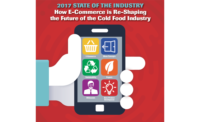Cold Food Trends Stand the Test of Time

When it comes to the refrigerated and frozen foods industry, one thing is for certain—new product development continues to prevail. Here’s a breakdown of some leading trends in the cold food industry that keep U.S. consumers coming back for more.
Restaurant performance improves
Over the last five years or so, the restaurant industry has faced some serious struggles. First, the economy tanked and took consumer spending with it. Then, consumers hopped on the healthy-eating bandwagon, forcing restaurants to quickly revamp their menus. However, the fast food and restaurant industry has bounced back thanks to a combination of convenient and affordable menu items that are fit for the every consumer.
In fact, in 2014, foodservice revenue is expected to grow an additional 1.4% to $198.9 billion, according to “Fast Food Restaurants in the U.S.-March 2014,” produced by IBIS World, Los Angeles. The fast food restaurant industry will continue to play an influential role in the U.S. foodservice sector over the next five years, yet will remain highly competitive on price and value. Many domestic operators will continue to expand internationally, with Asia and the Middle East being regions where domestic fast food brands have yet to saturate the market, the report continues.
Meanwhile, fast-casual restaurants continue to align with consumers’ needs, according to Chicago-based Technomic, with unit expansion happening in burger, Mexican, sandwich and specialty concepts.
“Watch for even more menu and concept-driven diversity in this sector,” says Darren Tristano, executive vice president of Technomic.
The ultimate grocery store experience
A study conducted by Market Force Information, Louisville, Colo., found that Trader Joe’s is North America’s favorite grocery retailer based on satisfaction (Publix and ALDI came in second and third, respectively).
On the other hand though, a study by Concentric Marketing, Charlotte, N.C., says only 27% of Millennials shop specialty and health food stores like Trader Joe’s and Whole Foods. Likewise, 52% of men surveyed equally share or take the lead in grocery shopping, while 65% handle the cooking.
Value still No. 1 priority
The Private Label Manufacturers Association (PLMA), New York, released a study stating that Millennials (who represent a multi-trillion dollar marketing opportunity for the food industry) deem value as their No. 1 priority when purchasing groceries. Brand loyalty is not a major pull, yet they seek out affordability and low prices. In fact, seven in 10 belong to a loyalty program.
“Millennials have revolutionized the way we communicate,” says Brian Sharoff, president of PLMA. “They have created a world of ‘likes’ and ‘friends’ larger than all television audiences combined.”
Organic not over yet
Sales of organic products in the United States jumped to $35.1 billion in 2013, up 11.5% from the previous year’s $31.5 billion and experiencing the fastest growth rate in five years, according to the Organic Trade Association (OTA), Washington, D.C. The $4.9 billion organic dairy sector grew 8%, however sales of organic beverages slowed to a 5% growth rate to around $4 billion.
“The U.S. organic market is experiencing strong expansion with organic food and farming continuing to gain in popularity. Consumers are making the correlation between what we eat and our health, and that knowledge is spurring heightened consumer interest in organic products,” says Laura Batcha, executive director and CEO of OTA.
However the trends unfold, refrigerated and frozen food processors continue to introduce new product offerings that keep consumers coming back for more.
To learn more about these and other cold food trends, check out Refrigerated & Frozen Foods’ State of the Industry report.
Looking for a reprint of this article?
From high-res PDFs to custom plaques, order your copy today!






